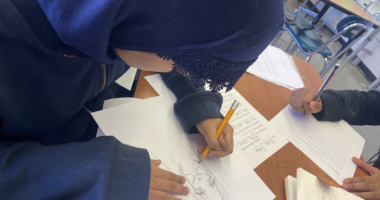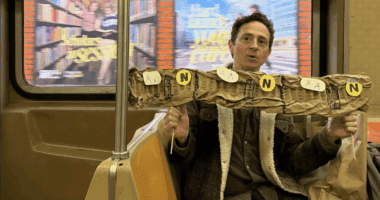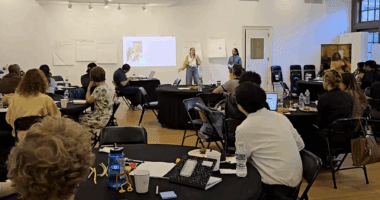Outside Voices is an interview series in which Community-Word Project catches up with current and former students to see how their participation in CWP’s creative art programs impacted their learning and growth.

Community-Word Project (CWP) first met Kayla Dike in high school at The Young Women’s Leadership School in Jamaica, Queens. Kayla participated in CWP’s arts residencies and CWP 2.0. A natural leader and powerful writer, Kayla has become a strong voice of our alum community since graduation. Kayla is currently a junior at SUNY Purchase studying studio engineering.
Kayla sat down, virtually, with CWP Board Member Lori Bullock to kick off the new interview series Outside Voices. Interview has been condensed and lightly edited for clarity.
Lori: Did your writing in high school with CWP change the way you thought about your future?
Kayla: My writing in high school with CWP really shaped my future because I was going to go into law, so before CWP, [my writing] was very argumentative essay [structured]. Life was similar to that. There was a beginning. There was an end. There [were] four steps in the middle that you had to take to get to the end, much like an essay. So after working with CWP in high school, I feel like I realized that life was much more fluid than that. There [are] different twists and turns to life. I feel like writing really helped me realize that it was way more free flowing than anything I was used to in a lot of public schools, like inner, inner city high school.
Lori: What ways did your art program prepare you for college?
Kayla: I’m planning to be a studio engineer. That’s kind of like the creativity mixed with the technology. [CWP] brought me to a tech class – and I never, literally never, considered myself a tech girl until I was just like, ‘Okay, we’re doing this. It’s something that we’re doing.’ I took a tech class last semester [at SUNY] and it helped bring so many things into perspective. So many things intersected that I didn’t know would at the time.
Lori: How does art show up and creative expression show up in your everyday life?
Kayla: I like to be a physical representation of art and the things that I like and I like to physically portray it. I’m extra – like I always go that extra mile with everything. And I feel like when you see me, it’s like you see my art, like [my] really long colorful braids. And that’s a part of my self-expression because to me our “selves” is our very being. How you present yourself shows who you are in some way, shape, or form. And as someone who wants to be bold, who wants to be big, I’m more of a “more is more” kind of person. I like to portray different beings just by looking at myself. Like, today I feel like I’m a nineties girl with a black hat, you know? I want to kind of give that vibe. Art is communication to me. It communicates an idea. It communicates a story. It communicates a past.
Lori: Did your experience with Community-Word Project change how you view your own creative expression in or out of school?
Kayla: CWP definitely did change my own creative expression because it affirmed me. I was used to getting praise for doing well on a test. There was a numerical amount for you to get, and you got 90% of them and you get affirmed for that. With CWP, I was affirmed in a different way, [for] things that cannot be graded. Your creativity, your expression, what you have to say about the world, is valid and positive. That changed my outlook on my creativity and my expression, because it was like, ‘Hey, people care. People can care.’ I can actually say that. People can care about what I say if I say it. I feel like that’s something that I really took from the program. If I can say something, and if I do say something, people can care. And it really changed the way I thought about things, because it’s like, hey, if people could care about what I’m saying in poetry, people can care about what I say about, you know, activism. People could care about what I say about, you know, my experience. People could care about what I say in general. So it definitely changed me for the better.
Lori: How are you going to use art to change the world?
Kayla: One beautiful thing about human connection is that [people] can have completely different thoughts on literally anything in the world and something can, say, inspire a whole movement within a simple conversation and a new perspective can change how you think about something completely. I feel like that’s what I want my art to do, whether it be to teach and to come from a place of you know, “This is history. This is a fact.” But also the cultural, social, importance of whatever I’m talking about. For example, right now I’m trying to talk about culture, religion, pre-colonialism, and preconceived notions. But I want to use art and poetry and even dance to show this. There’s so much social language between us. There’s so much cultural language and I feel like art is a moving factor because as the human race, we never stay stagnant. I feel like art moves us in another direction. I want to use art as a way to break down isms. I want to use art to break down isms and phobias and just inspire new ways of thinking.
Lori: So do you think arts education is a critical part of the educational experience?
Kayla: Art is definitely critical in education. I feel like we let down so many students by only teaching STEM. Art in all its capacities should be in school because there are so many students who will never know about all the amazing things they can do outside of being an engineer. Outside of being a lawyer. Outside of being a doctor. I feel like we really fail these students because there are so many people with amazing things to say with beautiful talents [and] the most awesome creativity ever. I feel like overall as a society, we’ll be so much better off if we let people create. I feel like creativity is always looked down upon because it’s not the same, stable career as being a doctor. But there’s so much creativity in schools. I feel like art brings joy to people that a lot of other things do not. When there’s a global pandemic, where everyone’s stuck in their house…no one’s really doing anything. What does everyone turn to? Art. Everyone turns on the music, you know? Everyone starts listening to podcasts, everyone starts watching TV. And that was created by artists. Whatever form they may have been, whether they are photographers, whether they are writers, whether they’re visual artists, whether they’re musicians, everyone turns to art. it just brings a joy that I feel like nothing else brings.



